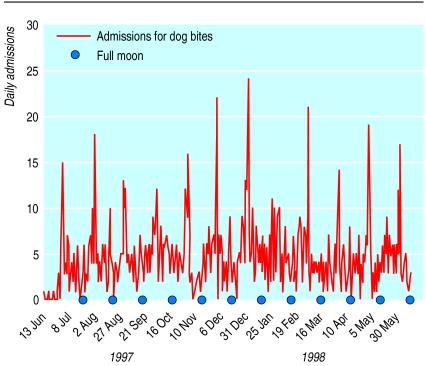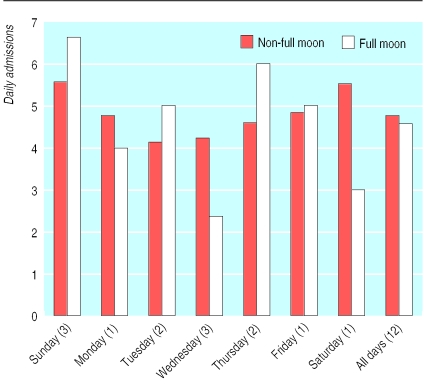Abstract
Objective
To assess whether dog bites requiring hospital admission occur more at the full moon.
Design
Review of dates of admission for dog bites to accident and emergency departments, June 1997 to June 1998, compared with dates of the full moon.
Setting
All public hospitals in Australia.
Main outcome measures
Admissions for dog bites.
Results
12 peak clusters of admissions were unrelated to the time of the full moon.
Conclusion
Dog bites are no more frequent on full moons than at any other time of the month. Sceptics rejoice.
Introduction
After publicity about the paper (by SC) on a randomised controlled trial to reduce dog bites,1 we were contacted by a farmer who asked: “Have you university types ever looked at whether dog bites happen more around the full moon? It's a well known fact that they do.” Farmers are often storehouses of folkloric knowledge said to be derived from a rich tradition of empirical observation of, for example, sky colour and the weather (“red sky at night, shepherd's delight; red sky in the morning, shepherd's warning”) or avoiding the wrath of bulls (“red rag to a bull”)—so we leashed our scepticism and investigated.
The influence of the full moon remains one of the more resilient popular explanations of a wide range of mostly traumatic or bizarre events. There is a pale reflection of this in epidemiology—recall bias—where those affected by a rare or severe disease are more inclined to associate unrelated non-disease exposures to the disease. Although more women have been documented to menstruate around the full moon,2 research has generally failed to confirm any association between the full moon and the manifestation of psychiatric disorders or violence in psychiatric settings,3,4 consultations for anxiety or depression in general practice,5 suicide and self poisoning,6,7 agitation among nursing home residents,8 car accidents,9 major trauma,10 or emergency department admissions.11
Weak associations have been reported between the full moon and the distribution of spontaneous full term deliveries,12 small increases in meal size and reduced alcohol consumption,13 unintentional poisonings,14 absenteeism,15 aggression in Dade County, Florida,16 and reports of crimes to three police stations in India between 1978 and 1982. The latter, in a nation devoted to astrology, was posited by the authors to be caused by “human tidal waves” caused by the gravitational pull of the moon.17
So it seems that humans are mostly impervious to putative effects of the full moon on mental health and behaviour. But what about our best friend, Phideau? Do howling dogs feel more inclined to bite humans during the full moon than at other times? Or are their barks worse than their bites when a human interrupts their canine arias? Such questions have dogged science for so long that they can no longer be ignawed.
Methods
We obtained from the National Injury Surveillance Unit 12 months of data on daily admissions for dog bites to all accident and emergency departments in public hospitals in Australia. We chose a year of data for analysis that would supply sufficient event numbers, both of dog bites and full moons, and would enable us to sniff out any seasonal variation in dog bite admissions. Age and sex of victims, but not perpetrators, were available. Daily admissions for 13 June 1997 to 12 June 1998 were plotted against the occurrence of a full moon. Mean daily admission numbers were analysed in relation to the presence or absence of a full moon, stratified by day of the week so that comparisons between full moon and non-full moon days were for the equivalent day of the week. Mean dog bite admissions during full moons occurring on, for example, a Monday were compared with dog bite admissions for all other Mondays.
Results
Altogether 1671 accident and emergency admissions for dog bites occurred during the study period (938 males, 733 females), representing an overall mean admission rate of 4.58 per day. Figure 1 shows 18 peak days (notionally >10 admissions/day), with the maximum peak centring on the New Year break (the highest peak (24) occurred on New Year's Day 1998). Full moons coincided with none of these peaks. The pattern was similar for female and male admissions.
Figure 1.
Daily admissions to hospital for dog bites, Australia, 13 June 1997 to 12 June 1998, and occurrence of full moon
Comparison of hospital admissions by day of the week is shown in figure 2. Mean daily admissions peaked at weekends (5.5 for Saturday, 5.6 for Sunday), and the number of admissions on weekdays ranged from 4.1 to 4.9, forming overall a U shaped distribution from Sunday to Saturday with the trough occurring on Wednesday. On Sunday, Tuesday, and Thursday the mean number of admissions was substantially higher when a full moon occurred; on Monday, Wednesday, and Saturday the mean number of admissions was substantially lower when a full moon occurred; and on Friday the mean was closely similar. This would be an expected result if dog bite admissions occurred randomly with respect to full moons. Overall, full moon days were associated with slightly lower mean admissions (4.6 compared with 4.8 per day).
Figure 2.
Mean daily admissions to hospital for dog bites, Australia, 13 June 1997 to 12 June 1998, by day of week (and with number of full moons occurring on each day during the study period), according to whether there was a full moon
Discussion
In Australia at least, no positive relation seems to exist between the full moon and dog bites severe enough for hospital treatment. Myers's critical appraisal of gravitational lunacy theory18 argued that, because tidal gravity fluxes are semidiurnal, with smaller diurnal and even smaller fortnightly components, there are no unique monthly gravitational components that would correspond to the period of the full moon. Also, the gravitational effects associated with the times of high tide are greater than those associated with moon phases. By applying this principle to absurd lengths, Myers suggested that any lunacy effects should occur twice each day with high tides and also should be more pronounced during the new moon and full moon (spring tides). Our data recorded time of bite, but investigation of Myers's hypothesis was muzzled by small numbers. As the plot of dog bite admissions and full moons clearly shows, more caution with dogs might be exercised over Christmas and especially at New Year—irrespective of the full moon.
What is already known on this topic
Farming folklore holds that dogs bite more at the time of full moons
The research literature on the effect of lunar phase on human behaviour has mostly shown no association
What this study adds
In Australia no association exists between lunar phase and dog bites requiring hospital admission
Acknowledgments
We thank Malinda Steenkamp from the National Injury Surveillance Unit, Adelaide, for data.
Footnotes
Funding: No special funding.
Competing interests: Neither author owns a dog, but both quite like them. They are unscarred by bites.
References
- 1.Chapman S, Cornwall J, Righetti J, Sung L. Preventing dog bite in children: a randomised controlled trial of an educational intervention. BMJ. 2000;320:1512–1513. doi: 10.1136/bmj.320.7248.1512. [DOI] [PMC free article] [PubMed] [Google Scholar]
- 2.Law SP. The regulation of menstrual cycle and its relationship to the moon. Acta Obstet Gynecol Scand. 1986;65:45–48. doi: 10.3109/00016348609158228. [DOI] [PubMed] [Google Scholar]
- 3.Raison CL, Klein HM, Steckler M. The moon and madness reconsidered. J Affect Disorders. 1999;53:99–106. doi: 10.1016/s0165-0327(99)00016-6. [DOI] [PubMed] [Google Scholar]
- 4.Owen C, Tarantello C, Jones M, Tennant C. Lunar cycles and violent behaviour. Aust N Z J Psychiatry. 1998;32:496–499. doi: 10.3109/00048679809068322. [DOI] [PubMed] [Google Scholar]
- 5.Wilkinson G, Piccinelli M, Roberts S, Micciolo R, Fry J. Lunar cycle and consultations for anxiety and depression in general practice. Int J Soc Psychiatry. 1997;43:29–34. doi: 10.1177/002076409704300103. [DOI] [PubMed] [Google Scholar]
- 6.Mathew VM, Lindesay J, Shanmuganathan N, Eapen V. Attempted suicide and the lunar cycle. Psychological Reports. 1991;68:927–930. doi: 10.2466/pr0.1991.68.3.927. [DOI] [PubMed] [Google Scholar]
- 7.Buckley NA, Whyte IM, Dawson AH. There are days . . . and moons. Self-poisoning is not lunacy. Med J Aust. 1993;159:786–789. [PubMed] [Google Scholar]
- 8.Cohen-Mansfield J, Marx MS, Werner P. Full moon: does it influence agitated nursing home residents? J Clin Psychol. 1989;45:611–614. doi: 10.1002/1097-4679(198907)45:4<611::aid-jclp2270450417>3.0.co;2-f. [DOI] [PubMed] [Google Scholar]
- 9.Laverty WH, Kelly IW. Cyclical calendar and lunar patterns in automobile property accidents and injury accidents. Perceptual & Motor Skills. 1998;86:299–302. doi: 10.2466/pms.1998.86.1.299. [DOI] [PubMed] [Google Scholar]
- 10.Coates W, Jehle D, Cottington E. Trauma and the full moon: a waning theory. Ann Emerg Med. 1989;18:763–765. doi: 10.1016/s0196-0644(89)80014-9. [DOI] [PubMed] [Google Scholar]
- 11.Thompson DA, Adams SL. The full moon and ED patient volumes: unearthing a myth. Am J Emerg Med. 1996;14:161–164. doi: 10.1016/S0735-6757(96)90124-2. [DOI] [PubMed] [Google Scholar]
- 12.Ghiandoni G, Secli R, Rocchi MB, Ugolini G. Does lunar position influence the time of delivery? A statistical analysis. Eur J Obst Gynecol Reprod Biol. 1998;77:47–50. doi: 10.1016/s0301-2115(97)00226-1. [DOI] [PubMed] [Google Scholar]
- 13.De Castro JM, Pearcey SM. Lunar rhythms of the meal and alcohol intake of humans. Physiol Behav. 1995;57:439–444. doi: 10.1016/0031-9384(94)00232-t. [DOI] [PubMed] [Google Scholar]
- 14.Oderda GM, Klein-Schwartz W. Lunar cycle and poison center calls. J Toxicol Clin Toxicol. 1983;20:487–495. doi: 10.3109/15563658308990614. [DOI] [PubMed] [Google Scholar]
- 15.Sands JM, Miller LE. Effects of moon phase and other temporal variables on absenteeism. Psychological Reports. 1991;69:959–962. doi: 10.2466/pr0.1991.69.3.959. [DOI] [PubMed] [Google Scholar]
- 16.Lieber AL. Human aggression and the lunar synodic cycle. J Clin Psychiatry. 1978;39:385–392. [PubMed] [Google Scholar]
- 17.Thakur CP, Sharma D. Full moon and crime. BMJ. 1984;289:1789–1791. doi: 10.1136/bmj.289.6460.1789. [DOI] [PMC free article] [PubMed] [Google Scholar]
- 18.Myers DE. Gravitational effects of the period of high tides and the new moon on lunacy. J Emerg Med. 1995;13:529–532. doi: 10.1016/0736-4679(95)80013-1. [DOI] [PubMed] [Google Scholar]




